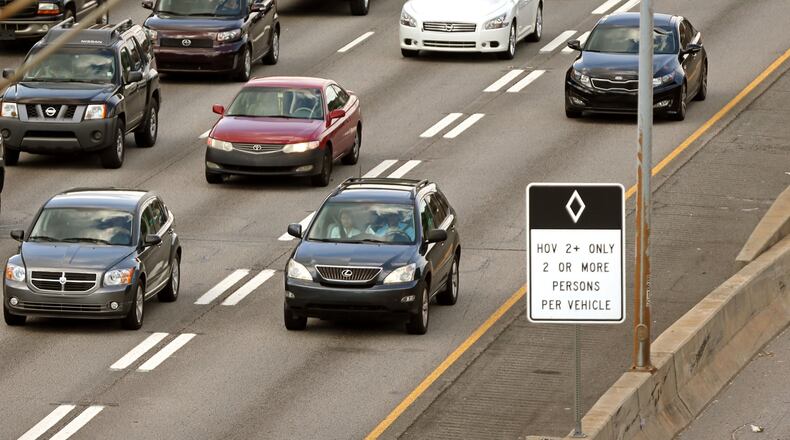What is the HOT lane?
The I‐85 HOT (High Occupancy Toll) lane opened on Oct. 1, 2011. As part of a pilot project, the state obtained federal funding to convert 15.5 miles of existing HOV lanes going north and south on I-85 in Gwinnett and DeKalb counties to express lanes. Buses, alternative-fuel vehicles and cars with three or more occupants can travel in the HOT lane for free. Others who choose to use the express lane must pay a toll. The lane volumes and speeds are constantly monitored and controlled using a variable toll rate to keep traffic flowing at 45 mph or greater.
Year/ Operating expense/ Toll revenue
FY 2012*/ $7.8 million/ $2.4 million
FY 2013**/ $7.4 million/ $5.7 million
*Fiscal year is July 1, 2011, to June 30, 2012. This fiscal year reflects only the first nine months that the HOT lane was in operation because it opened on Oct. 1, 2011.
** Fiscal year is July 1, 2012 to June 30, 2013.
*** According to the State Road and Tollway Authority.
More toll lanes coming:
- Plans are under way to build a $176 million optional toll lane project on I-75 South in Henry and Clayton counties by December 2016.
- Next year, construction will start on an $840 million optional toll lane project on I-75/I-575 in Cobb and Cherokee counties that is expected to be completed by the spring of 2018.
- The state also plans to build a northern extension of the I-85 HOT lane with a new lane that would stretch 10 miles north to Hamilton Mill Road.
Jorge Basto fights the impulse every weekday morning driving from his Lawrenceville subdivision to downtown.
He endures the creep down Ga. 316. He even slogs through a soup of cars and trucks near Gwinnett Place Mall. But by the time he reaches Jimmy Carter Boulevard, he can no longer resist the lure of free-flowing traffic in the HOT lane.
Basto knows that a simple maneuver into that far-left lane can shave off up to a third of his normal 90-minute commute. But these days that convenience is coming at a steeper cost.
Drivers such as Basto feel they have little choice but to use the lane, but two years after it opened, state officials see its increased use as reinforcing their long-term plan to build a network of new optional toll lanes in metro Atlanta. The daily average price of the toll over 24 hours ($1.72) and the average number of drivers using it per day (20,768) have reached all-time highs. And while motorists were slow to embrace the state’s first HOT lane when it opened, as its initial revenue figures show, a quarter of a million Peach Pass transponders have been issued, more than double the amount in circulation when the lane opened.
By those measures, the ramp-up of the first few years has gone faster than predicted, said Chris Tomlinson, executive director of the State Road and Tollway Authority.
“I don’t think we are quite out of the growth spurt,” Tomlinson said. “That isn’t just because revenue numbers are higher. We are still sending out a significant amount of Peach Passes each week and we are not doing any advertising.”
Transportation officials call that a success story. They say it means people are using the optional toll lane more because they’re beginning to view it as that rarest of assets — a predictable travel option in traffic-snarled metro Atlanta.
“That lane has proven to be very successful,” Gov. Nathan Deal told The Atlanta Journal-Constitution last month. “And that’s what it was created for — to take as much pressure off the other lanes as possible.”
In reality, the state is still studying its impact on traffic in other lanes.
Deal made his remarks about success on Sept. 11, when the morning rush-hour price to drive the entire 15.5-mile stretch shot to a record $8.
Drivers haven’t been so quick to applaud.
“Without sounding too harsh, it’s almost extortion,” Basto said. “You almost feel forced to use that lane at times because you see that flow moving.”
It cost about $60 million to convert the HOV lane to the HOT lane.
The project got off to a rocky start when it opened in 2011. Because only car pools of three or more could continue to ride free, two-person car pools got kicked into the general-purpose lanes and created more congestion there.
Tomlinson said the restriction was necessary because HOV lanes were already starting to bog down because of two-person car pools. He said adding toll-paying vehicles into the mix would have clogged them to the point they were no longer functional.
But the fact that two-person car pools were ejected from the lane still chafes LeRoy Garcia, a 54-year-old Lawrenceville van-pool rider who believes anyone trying to ride-share should be rewarded.
“I think people that were actually doing the right thing and trying to save space on the road got kind of screwed over by having to pay or go to the general-purpose lane,” Garcia said.
That wasn’t the only problem encountered early on with the HOT lane. So few people were using them that a week after they opened, the state had to drastically cut the rate during off-peak times from a dime to a penny a mile.
Not surprisingly, that caused the first nine months’ revenue to come in at $2.4 million, well short of even the state’s lowest predictions (which ranged from $2.5 million to $5 million).
Annual revenue has since grown to $5.7 million, within the range projected for fiscal year 2013 of $4.4 million to $8.7 million. The lane still runs at a deficit, however, because the annual operating costs were $7.4 million.
State transportation officials say the purpose of the lane is not to generate revenue. Instead, it is to keep one lane moving reliably at 45 mph or faster for those willing to pay the price. The toll rises and falls between 1 cent and 90 cents a mile depending on the amount of traffic in the lane.
The record rate of $8 reached last month averages out to 50 cents per mile, far short of the maximum charge under state policy. But even with the current level of growth, Tomlinson said “I would be surprised if we ever see that ultimate rate ever being hit.”
An ongoing criticism of the lane has been that it is a “Lexus Lane,” benefiting only the wealthy, and that it does little to improve traffic for everyone else.
A recent study by the Southern Environmental Law Center was the first to look at the relationship between income levels and use of the lane. Researchers found residents of the ZIP code with the highest median income use the lane at rates five times greater than people living in the lowest median income ZIP code. The study, however, was based on limited data over a short time frame.
A state-funded study on various aspects of the impact of the HOT lane — such as the effect it has had on commute times in the general-purpose lanes, plus the socio-economic groups that make up its users — is expected to be released later this year.
But officials say the HOT lane does benefit everyone because it gives everyone a choice. The data show that most of the people using the HOT lane don’t view it as a daily commute option. Only a third of HOT lane users ride in the lane more than three times a week. The remaining users take advantage of it only occasionally, according to SRTA.
Like them or not, toll lanes are here to stay.
In fact, a third of the $15.8 billion that the state budgeted for all new transportation expansion through the year 2040 will go toward building optional toll lanes in metro Atlanta.
Included in those plans is a northern extension of the I-85 HOT lane with a new lane that would stretch to Hamilton Mill Road.
About the Author
Keep Reading
The Latest
Featured


